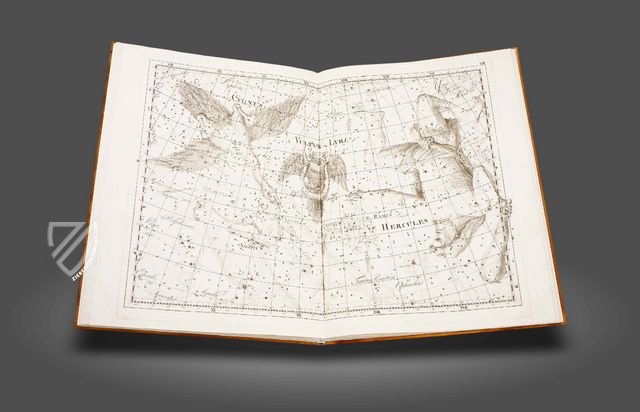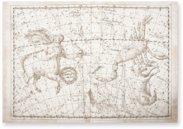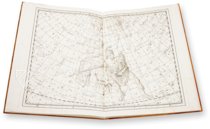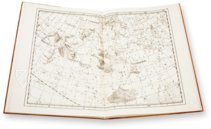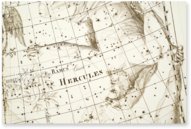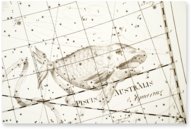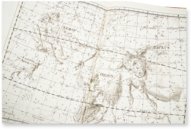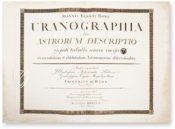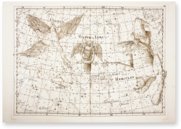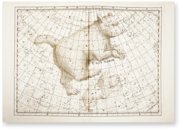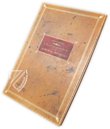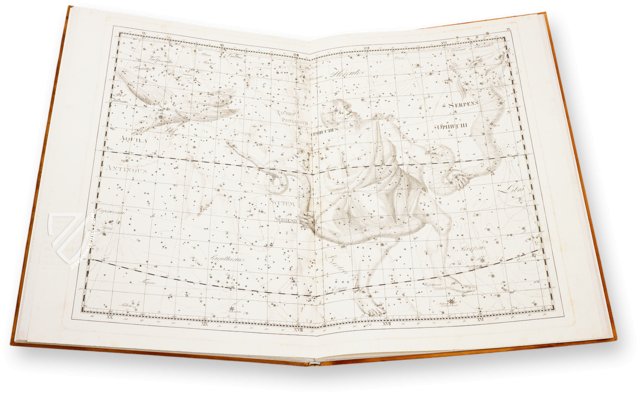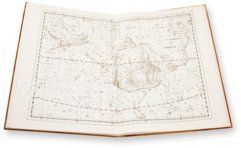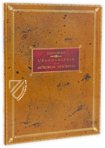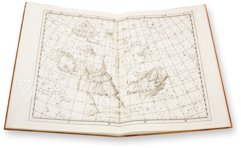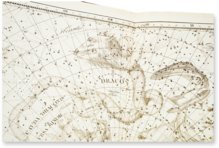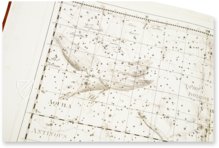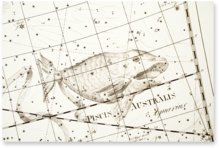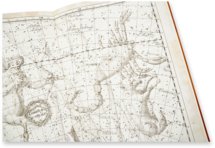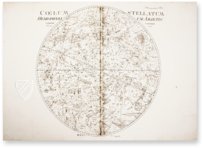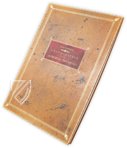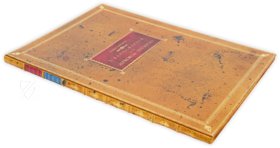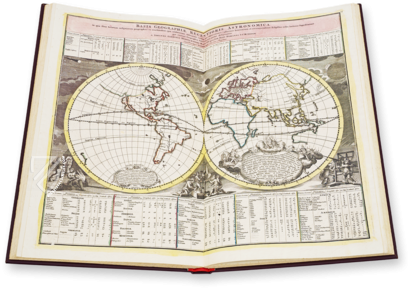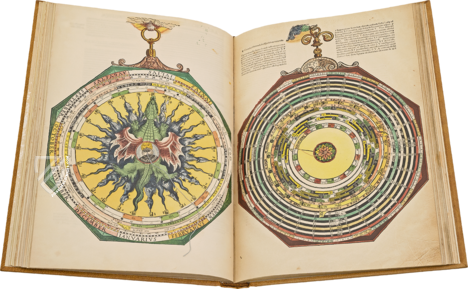Uranographia
(1,000€ - 3,000€)
Johann Elert Bode is counted among the most significant German astronomers of the 18th century. He postulated equations and mathematical formulas for the calculation of planetary orbits, which made possible the discovery of Neptune inter alia by his successors. Appearing in multiple editions between 1796 and 1801, his Uranographia represents his astronomical findings in the most beautiful and artistically attractive way. The book is considered to be a true best seller of the Early Modern Period and simultaneously represents the last masterpiece of artistic celestial cartography.
Uranographia
Uranographia sive astrorum description, such is the title of one of the most important astronomical works of the 18th century. The text, the title translates to Uranography or the Description of the Stars, was composed between 1791 and 1802 by the German astronomer Johann Elert Bode. It is considered today to be the last great masterpiece of artistic celestial cartography. The spectacular star atlas comprised 20 celestial maps with a directory of a total of 17,240 planets, stellar nebulae, and binary stars. The original specimen of the atlas is found today in the university library of the Nicolaus Copernicus Institute in the Polish city of Torun.
The Astronomer Johann Elert Bode
Johann Elert Bode was born in Hamburg in the year 1747. Together with his eight sisters, he was educated by his father, an esteemed Hamburg merchant. Johann Bode's scientific curiosity, his interest in mathematics and physics already made him notable in his youth. In 1765, he was introduced through a family friend to Johann Georg Bürsch, a teacher of mathematics at Hamburg’s Akademischen Gymnasium. After speaking with him, he was impressed with the youngster’s intelligence and calculative skills, and permitted him to make use of his library and the instruments of his collection for private study. His first scientific treatise was published in 1766, when Bode was 19. It was concerned with a solar eclipse on August 5th, 1766. Additional treatises for the calculation of the movement of the planets followed, in which Bode inter alia postulated an empirical formula for the calculation of the spacing of planetary orbits from the Sun. In 1776, Bode functioned as the publisher of the first Berliner Astronomisches Jahrbuch, the most renowned astronomical publication series worldwide. He is counted today among the most important astronomers of world history.
The Discovery of Uranus
Johann Bode became famous in professional circles above all because of his work on the orbit of Uranus, discovered in 1781. The planet, which is visible with the naked eye from Earth, already appeared in very early star catalogs. Bode discovered its position in a catalog published in 1690 by the English court astronomer John Flamsteed, where it was registered under the designation Tauri 34. He calculated the planetary orbit of Uranus with a high degree of accuracy and his observations of the surrounding planets led to the discovery of Neptune in 1846. The naming of Uranus is traced to a suggestion of Bode’s.
The Scientist’s Masterpiece
The Uranographia is one of two star atlases that Bode published and is by far his most important work. He depicted his astronomical findings and his scientific research in a grateful, artistically pleasing manner. His star constellations are deposited with visual interpretations of people, animals, and celestial phenomena. The printed book, whose style corresponds completely to the scientific spirit of Renaissance humanism, was bound in a special manner. The pages were stuck to the book spine in such a way that one can open the book completely and spread it flat. Consequently, every detail of the astounding star maps are visible. Bode’s artistic atlas is the most masterful and simultaneously the last of of its genre ever to be printed.
Codicology
- Alternative Titles
- Joannis Elerti Bode, Uranographia sive astrorum descriptio
- Size / Format
- 44 pages / 65.0 × 45.5 cm
- Origin
- Germany
- Date
- 1797–1801
- Epochs
- Style
- Genre
- Language
- Artist / School
- Johann Elert Bode
- Previous Owners
- Toruń library of the Protestant Academic Gymnasium
Coppernicus-Verein für Wissenschaft und Kunst (Toruń, Poland)
Uranographia
Hot Air Balloon and Microscope
Capricorn bounds across the sky and over two of the most important inventions of the Early Modern Era: the compound microscope and the hot air balloon. The first manned balloon flight occurred in Paris on November 21, 1783 – only a few years before the publication of this work. It was an exciting event that would lead to the first moon landing only 186 years later. Although less glamorous, the development of the microscope in early-17th century Europe would change the way we see the world.

Uranographia
Ursa Major and Ursa Minor
This page represents one of the last and greatest masterpieces of artistic celestial cartography, whereby the incredibly accurate findings of Early Modern astronomers were presented in the imaginative trappings of the constellations’ mythical conceptions. This 18th century printed work presents two of the original 48 Ptolemaic constellations.
In Roman mythology, Jupiter lusts after Callisto, a nymph of Diana, who is turned into a bear by his jealous wife, Juno. Callisto’s son, Arcas, nearly kills his mother before Jupiter turns him into a bear as well and puts them in the sky, forming the constellations Ursa Major and Ursa Minor. The Big and Little Bears are presented with artistry that blends seamlessly with the precise mapping of the grid pattern.
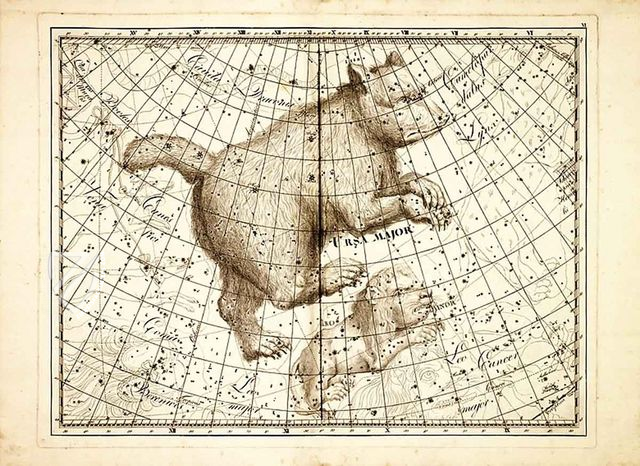
#1 Uranographia
Languages: English, Polish
(1,000€ - 3,000€)
- Treatises / Secular Books
- Apocalypses / Beatus
- Astronomy / Astrology
- Bestiaries
- Bibles / Gospels
- Chronicles / History / Law
- Geography / Maps
- Saints' Lives
- Islam / Oriental
- Judaism / Hebrew
- Single Leaf Collections
- Leonardo da Vinci
- Literature / Poetry
- Liturgical Manuscripts
- Medicine / Botany / Alchemy
- Music
- Mythology / Prophecies
- Psalters
- Other Religious Books
- Games / Hunting
- Private Devotion Books
- Other Genres
- Afghanistan
- Armenia
- Austria
- Belgium
- Belize
- Bosnia and Herzegovina
- China
- Colombia
- Costa Rica
- Croatia
- Cyprus
- Czech Republic
- Denmark
- Egypt
- El Salvador
- Ethiopia
- France
- Germany
- Greece
- Guatemala
- Honduras
- Hungary
- India
- Iran
- Iraq
- Israel
- Italy
- Japan
- Jordan
- Kazakhstan
- Kyrgyzstan
- Lebanon
- Liechtenstein
- Luxembourg
- Mexico
- Morocco
- Netherlands
- Palestine
- Panama
- Peru
- Poland
- Portugal
- Romania
- Russia
- Serbia
- Spain
- Sri Lanka
- Sweden
- Switzerland
- Syria
- Tajikistan
- Turkey
- Turkmenistan
- Ukraine
- United Kingdom
- United States
- Uzbekistan
- Vatican City
- A. Oosthoek, van Holkema & Warendorf
- Aboca Museum
- Ajuntament de Valencia
- Akademie Verlag
- Akademische Druck- u. Verlagsanstalt (ADEVA)
- Aldo Ausilio Editore - Bottega d’Erasmo
- Alecto Historical Editions
- Alkuin Verlag
- Almqvist & Wiksell
- Amilcare Pizzi
- Andreas & Andreas Verlagsbuchhandlung
- Archa 90
- Archiv Verlag
- Archivi Edizioni
- Arnold Verlag
- ARS
- Ars Magna
- ArtCodex
- AyN Ediciones
- Azimuth Editions
- Badenia Verlag
- Bärenreiter-Verlag
- Belser Verlag
- Belser Verlag / WK Wertkontor
- Benziger Verlag
- Bernardinum Wydawnictwo
- BiblioGemma
- Biblioteca Apostolica Vaticana (Vaticanstadt, Vaticanstadt)
- Bibliotheca Palatina Faksimile Verlag
- Bibliotheca Rara
- Boydell & Brewer
- Bramante Edizioni
- Bredius Genootschap
- Brepols Publishers
- British Library
- C. Weckesser
- Caixa Catalunya
- Canesi
- CAPSA, Ars Scriptoria
- Caratzas Brothers, Publishers
- Carus Verlag
- Casamassima Libri
- Centrum Cartographie Verlag GmbH
- Chavane Verlag
- Christian Brandstätter Verlag
- Circulo Cientifico
- Club Bibliófilo Versol
- Club du Livre
- CM Editores
- Collegium Graphicum
- Collezione Apocrifa Da Vinci
- Comissão Nacional para as Comemorações dos Descobrimentos Portugueses
- Coron Verlag
- Corvina
- CTHS
- D. S. Brewer
- Damon
- De Agostini/UTET
- De Nederlandsche Boekhandel
- De Schutter
- Deuschle & Stemmle
- Deutscher Verlag für Kunstwissenschaft
- DIAMM
- Droz
- E. Schreiber Graphische Kunstanstalten
- Ediciones Boreal
- Ediciones Grial
- Ediclube
- Edições Inapa
- Edilan
- Editalia
- Edition Deuschle
- Edition Georg Popp
- Edition Leipzig
- Edition Libri Illustri
- Editiones Reales Sitios S. L.
- Éditions de l'Oiseau Lyre
- Editions Medicina Rara
- Editorial Casariego
- Editorial Mintzoa
- Editrice Antenore
- Editrice Velar
- Edizioni Edison
- Egeria, S.L.
- Eikon Editores
- Electa
- Emery Walker Limited
- Enciclopèdia Catalana
- Eos-Verlag
- Ephesus Publishing
- Ernst Battenberg
- Eugrammia Press
- Extraordinary Editions
- Fackelverlag
- Facsimila Art & Edition
- Facsimile Editions Ltd.
- Facsimilia Art & Edition Ebert KG
- Faksimile Verlag
- Feuermann Verlag
- Folger Shakespeare Library
- Franco Cosimo Panini Editore
- Friedrich Wittig Verlag
- Fundación Hullera Vasco-Leonesa
- G. Braziller
- Gabriele Mazzotta Editore
- Gebr. Mann Verlag
- Gesellschaft für graphische Industrie
- Getty Research Institute
- Giovanni Domenico de Rossi
- Giunti Editore
- Graffiti
- Grafica European Center of Fine Arts
- Guido Pressler
- Guillermo Blazquez
- Gustav Kiepenheuer
- H. N. Abrams
- Harrassowitz
- Harvard University Press
- Helikon
- Hendrickson Publishers
- Henning Oppermann
- Herder Verlag
- Hes & De Graaf Publishers
- Hoepli
- Holbein-Verlag
- Houghton Library
- Hugo Schmidt Verlag
- Idion Verlag
- Il Bulino, edizioni d'arte
- ILte
- Imago
- Insel Verlag
- Insel-Verlag Anton Kippenberger
- Instituto de Estudios Altoaragoneses
- Instituto Nacional de Antropología e Historia
- Introligatornia Budnik Jerzy
- Istituto dell'Enciclopedia Italiana - Treccani
- Istituto Ellenico di Studi Bizantini e Postbizantini
- Istituto Geografico De Agostini
- Istituto Poligrafico e Zecca dello Stato
- Italarte Art Establishments
- Jan Thorbecke Verlag
- Johnson Reprint Corporation
- Josef Stocker
- Josef Stocker-Schmid
- Jugoslavija
- Karl W. Hiersemann
- Kasper Straube
- Kaydeda Ediciones
- Kindler Verlag / Coron Verlag
- Kodansha International Ltd.
- Konrad Kölbl Verlag
- Kurt Wolff Verlag
- La Liberia dello Stato
- La Linea Editrice
- La Meta Editore
- Lambert Schneider
- Landeskreditbank Baden-Württemberg
- Leo S. Olschki
- Les Incunables
- Liber Artis
- Library of Congress
- Libreria Musicale Italiana
- Lichtdruck
- Lito Immagine Editore
- Lumen Artis
- Lund Humphries
- M. Moleiro Editor
- Maison des Sciences de l'homme et de la société de Poitiers
- Manuscriptum
- Martinus Nijhoff
- Maruzen-Yushodo Co. Ltd.
- MASA
- Massada Publishers
- McGraw-Hill
- Metropolitan Museum of Art
- Militos
- Millennium Liber
- Müller & Schindler
- Nahar - Stavit
- Nahar and Steimatzky
- National Library of Wales
- Neri Pozza
- Nova Charta
- Oceanum Verlag
- Odeon
- Orbis Mediaevalis
- Orbis Pictus
- Österreichische Staatsdruckerei
- Oxford University Press
- Pageant Books
- Parzellers Buchverlag
- Patrimonio Ediciones
- Pattloch Verlag
- PIAF
- Pieper Verlag
- Plon-Nourrit et cie
- Poligrafiche Bolis
- Presses Universitaires de Strasbourg
- Prestel Verlag
- Princeton University Press
- Prisma Verlag
- Priuli & Verlucca, editori
- Pro Sport Verlag
- Propyläen Verlag
- Pytheas Books
- Quaternio Verlag Luzern
- Reales Sitios
- Recht-Verlag
- Reichert Verlag
- Reichsdruckerei
- Reprint Verlag
- Riehn & Reusch
- Roberto Vattori Editore
- Rosenkilde and Bagger
- Roxburghe Club
- Salerno Editrice
- Saltellus Press
- Sandoz
- Sarajevo Svjetlost
- Schöck ArtPrint Kft.
- Schulsinger Brothers
- Scolar Press
- Scrinium
- Scripta Maneant
- Scriptorium
- Shazar
- Siloé, arte y bibliofilia
- SISMEL - Edizioni del Galluzzo
- Sociedad Mexicana de Antropología
- Société des Bibliophiles & Iconophiles de Belgique
- Soncin Publishing
- Sorli Ediciones
- Stainer and Bell
- Studer
- Styria Verlag
- Sumptibus Pragopress
- Szegedi Tudomànyegyetem
- Taberna Libraria
- Tarshish Books
- Taschen
- Tempus Libri
- Testimonio Compañía Editorial
- Thames and Hudson
- The Clear Vue Publishing Partnership Limited
- The Facsimile Codex
- The Folio Society
- The Marquess of Normanby
- The Richard III and Yorkist History Trust
- Tip.Le.Co
- TouchArt
- TREC Publishing House
- TRI Publishing Co.
- Trident Editore
- Tuliba Collection
- Typis Regiae Officinae Polygraphicae
- Union Verlag Berlin
- Universidad de Granada
- University of California Press
- University of Chicago Press
- Urs Graf
- Vallecchi
- Van Wijnen
- VCH, Acta Humaniora
- VDI Verlag
- VEB Deutscher Verlag für Musik
- Verlag Anton Pustet / Andreas Verlag
- Verlag Bibliophile Drucke Josef Stocker
- Verlag der Münchner Drucke
- Verlag für Regionalgeschichte
- Verlag Styria
- Vicent Garcia Editores
- W. Turnowski Ltd.
- W. Turnowsky
- Waanders Printers
- Wiener Mechitharisten-Congregation (Wien, Österreich)
- Wissenschaftliche Buchgesellschaft
- Wissenschaftliche Verlagsgesellschaft
- Wydawnictwo Dolnoslaskie
- Xuntanza Editorial
- Zakład Narodowy
- Zollikofer AG

